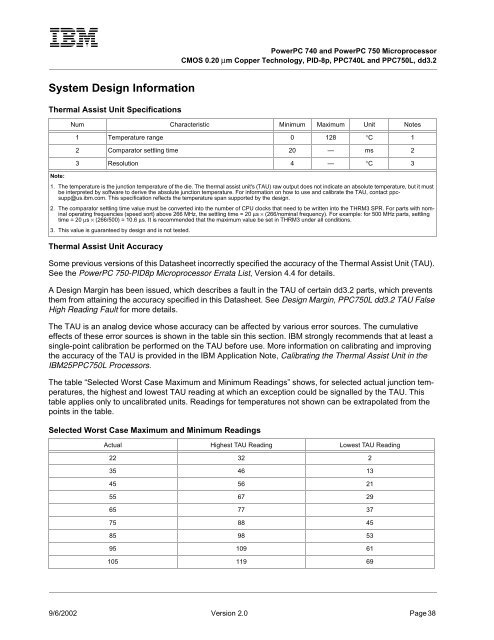PowerPC 740 and PowerPC 750 Microprocessor Datasheet - IBM
PowerPC 740 and PowerPC 750 Microprocessor Datasheet - IBM
PowerPC 740 and PowerPC 750 Microprocessor Datasheet - IBM
- No tags were found...
You also want an ePaper? Increase the reach of your titles
YUMPU automatically turns print PDFs into web optimized ePapers that Google loves.
<strong>PowerPC</strong> <strong>740</strong> <strong>and</strong> <strong>PowerPC</strong> <strong>750</strong> <strong>Microprocessor</strong>CMOS 0.20 µm Copper Technology, PID-8p, PPC<strong>740</strong>L <strong>and</strong> PPC<strong>750</strong>L, dd3.2System Design InformationThermal Assist Unit SpecificationsNum Characteristic Minimum Maximum Unit Notes1 Temperature range 0 128 °C 12 Comparator settling time 20 — ms 23 Resolution 4 — °C 3Note:1. The temperature is the junction temperature of the die. The thermal assist unit's (TAU) raw output does not indicate an absolute temperature, but it mustbe interpreted by software to derive the absolute junction temperature. For information on how to use <strong>and</strong> calibrate the TAU, contact ppcsupp@us.ibm.com.This specification reflects the temperature span supported by the design.2. The comparator settling time value must be converted into the number of CPU clocks that need to be written into the THRM3 SPR. For parts with nominaloperating frequencies (speed sort) above 266 MHz, the settling time = 20 µs × (266/nominal frequency). For example: for 500 MHz parts, settlingtime = 20 µs × (266/500) = 10.6 µs. It is recommended that the maximum value be set in THRM3 under all conditions.3. This value is guaranteed by design <strong>and</strong> is not tested.Thermal Assist Unit AccuracySome previous versions of this <strong>Datasheet</strong> incorrectly specified the accuracy of the Thermal Assist Unit (TAU).See the <strong>PowerPC</strong> <strong>750</strong>-PID8p <strong>Microprocessor</strong> Errata List, Version 4.4 for details.A Design Margin has been issued, which describes a fault in the TAU of certain dd3.2 parts, which preventsthem from attaining the accuracy specified in this <strong>Datasheet</strong>. See Design Margin, PPC<strong>750</strong>L dd3.2 TAU FalseHigh Reading Fault for more details.The TAU is an analog device whose accuracy can be affected by various error sources. The cumulativeeffects of these error sources is shown in the table sin this section. <strong>IBM</strong> strongly recommends that at least asingle-point calibration be performed on the TAU before use. More information on calibrating <strong>and</strong> improvingthe accuracy of the TAU is provided in the <strong>IBM</strong> Application Note, Calibrating the Thermal Assist Unit in the<strong>IBM</strong>25PPC<strong>750</strong>L Processors.The table “Selected Worst Case Maximum <strong>and</strong> Minimum Readings” shows, for selected actual junction temperatures,the highest <strong>and</strong> lowest TAU reading at which an exception could be signalled by the TAU. Thistable applies only to uncalibrated units. Readings for temperatures not shown can be extrapolated from thepoints in the table.Selected Worst Case Maximum <strong>and</strong> Minimum ReadingsActual Highest TAU Reading Lowest TAU Reading22 32 235 46 1345 56 2155 67 2965 77 3775 88 4585 98 5395 109 61105 119 699/6/2002 Version 2.0 Page 38
















